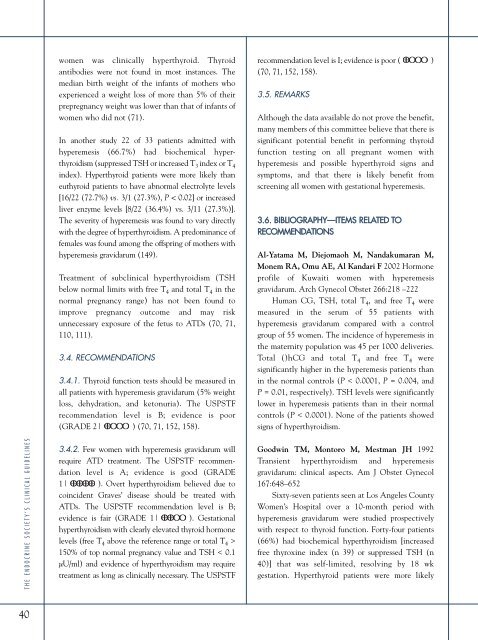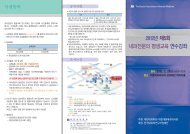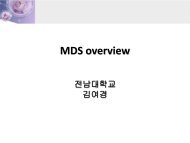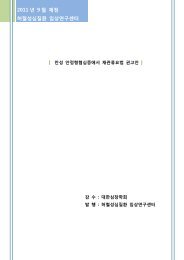Management of thyroid dysfunction during pregnancy and postpartum
Management of thyroid dysfunction during pregnancy and postpartum
Management of thyroid dysfunction during pregnancy and postpartum
Create successful ePaper yourself
Turn your PDF publications into a flip-book with our unique Google optimized e-Paper software.
THE ENDOCRINE SOCIETY’S CLINICAL GUIDELINES<br />
women was clinically hyper<strong>thyroid</strong>. Thyroid<br />
antibodies were not found in most instances. The<br />
median birth weight <strong>of</strong> the infants <strong>of</strong> mothers who<br />
experienced a weight loss <strong>of</strong> more than 5% <strong>of</strong> their<br />
pre<strong>pregnancy</strong> weight was lower than that <strong>of</strong> infants <strong>of</strong><br />
women who did not (71).<br />
In another study 22 <strong>of</strong> 33 patients admitted with<br />
hyperemesis (66.7%) had biochemical hyper<strong>thyroid</strong>ism<br />
(suppressed TSH or increased T 3 index or T 4<br />
index). Hyper<strong>thyroid</strong> patients were more likely than<br />
eu<strong>thyroid</strong> patients to have abnormal electrolyte levels<br />
[16/22 (72.7%) vs. 3/1 (27.3%), P < 0.02] or increased<br />
liver enzyme levels [8/22 (36.4%) vs. 3/11 (27.3%)].<br />
The severity <strong>of</strong> hyperemesis was found to vary directly<br />
with the degree <strong>of</strong> hyper<strong>thyroid</strong>ism. A predominance <strong>of</strong><br />
females was found among the <strong>of</strong>fspring <strong>of</strong> mothers with<br />
hyperemesis gravidarum (149).<br />
Treatment <strong>of</strong> subclinical hyper<strong>thyroid</strong>ism (TSH<br />
below normal limits with free T 4 <strong>and</strong> total T 4 in the<br />
normal <strong>pregnancy</strong> range) has not been found to<br />
improve <strong>pregnancy</strong> outcome <strong>and</strong> may risk<br />
unnecessary exposure <strong>of</strong> the fetus to ATDs (70, 71,<br />
110, 111).<br />
3.4. RECOMMENDATIONS<br />
3.4.1. Thyroid function tests should be measured in<br />
all patients with hyperemesis gravidarum (5% weight<br />
loss, dehydration, <strong>and</strong> ketonuria). The USPSTF<br />
recommendation level is B; evidence is poor<br />
(GRADE 2| ) (70, 71, 152, 158).<br />
3.4.2. Few women with hyperemesis gravidarum will<br />
require ATD treatment. The USPSTF recommendation<br />
level is A; evidence is good (GRADE<br />
1| ). Overt hyper<strong>thyroid</strong>ism believed due to<br />
coincident Graves’ disease should be treated with<br />
ATDs. The USPSTF recommendation level is B;<br />
evidence is fair (GRADE 1| ). Gestational<br />
hyper<strong>thyroid</strong>ism with clearly elevated <strong>thyroid</strong> hormone<br />
levels (free T 4 above the reference range or total T 4 ><br />
150% <strong>of</strong> top normal <strong>pregnancy</strong> value <strong>and</strong> TSH < 0.1<br />
µU/ml) <strong>and</strong> evidence <strong>of</strong> hyper<strong>thyroid</strong>ism may require<br />
treatment as long as clinically necessary. The USPSTF<br />
recommendation level is I; evidence is poor ( )<br />
(70, 71, 152, 158).<br />
3.5. REMARKS<br />
Although the data available do not prove the benefit,<br />
many members <strong>of</strong> this committee believe that there is<br />
significant potential benefit in performing <strong>thyroid</strong><br />
function testing on all pregnant women with<br />
hyperemesis <strong>and</strong> possible hyper<strong>thyroid</strong> signs <strong>and</strong><br />
symptoms, <strong>and</strong> that there is likely benefit from<br />
screening all women with gestational hyperemesis.<br />
3.6. BIBLIOGRAPHY—ITEMS RELATED TO<br />
RECOMMENDATIONS<br />
Al-Yatama M, Diejomaoh M, N<strong>and</strong>akumaran M,<br />
Monem RA, Omu AE, Al K<strong>and</strong>ari F 2002 Hormone<br />
pr<strong>of</strong>ile <strong>of</strong> Kuwaiti women with hyperemesis<br />
gravidarum. Arch Gynecol Obstet 266:218 –222<br />
Human CG, TSH, total T 4 , <strong>and</strong> free T 4 were<br />
measured in the serum <strong>of</strong> 55 patients with<br />
hyperemesis gravidarum compared with a control<br />
group <strong>of</strong> 55 women. The incidence <strong>of</strong> hyperemesis in<br />
the maternity population was 45 per 1000 deliveries.<br />
Total ()hCG <strong>and</strong> total T 4 <strong>and</strong> free T 4 were<br />
significantly higher in the hyperemesis patients than<br />
in the normal controls (P < 0.0001, P = 0.004, <strong>and</strong><br />
P = 0.01, respectively). TSH levels were significantly<br />
lower in hyperemesis patients than in their normal<br />
controls (P < 0.0001). None <strong>of</strong> the patients showed<br />
signs <strong>of</strong> hyper<strong>thyroid</strong>ism.<br />
Goodwin TM, Montoro M, Mestman JH 1992<br />
Transient hyper<strong>thyroid</strong>ism <strong>and</strong> hyperemesis<br />
gravidarum: clinical aspects. Am J Obstet Gynecol<br />
167:648–652<br />
Sixty-seven patients seen at Los Angeles County<br />
Women’s Hospital over a 10-month period with<br />
hyperemesis gravidarum were studied prospectively<br />
with respect to <strong>thyroid</strong> function. Forty-four patients<br />
(66%) had biochemical hyper<strong>thyroid</strong>ism [increased<br />
free thyroxine index (n 39) or suppressed TSH (n<br />
40)] that was self-limited, resolving by 18 wk<br />
gestation. Hyper<strong>thyroid</strong> patients were more likely<br />
40

















